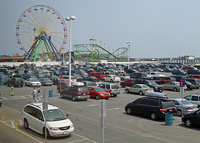Transit to the Eastern Shore?
BeyondDC recommends a transit link, such as an express bus lane, over the Chesapeake Bay Bridge to Ocean City. Like many other residents of the DC area, I would love to take the train to the shore, saving the trouble of driving and parking to enjoy a weekend on the beach. It would be even better to bring commuter rail (such as MARC) to the Eastern Shore if it were ever feasible to do so. Cities like Easton, Denton, Cambridge, and Salisbury could benefit from the commuting options. And of course, the resorts of Ocean City would benefit from a new demographic. If adding a new freeway span means also adding extra transit options across the Chesapeake Bay, the only drawback to such a project is the price tag.
To be fair, Ocean City owes its boom to the automobile. Vehicular connections across the Chesapeake from Annapolis in 1952 and Norfolk in 1964 opened the resort town to vacationers from several new metropolitan areas. Since then, rural bypasses and traffic control measures along US-50, locally known in Eastern Maryland as Ocean Gateway, have shortened the drive from the Bay Bridge to Ocean City to about two hours. That is, of course, unless there is traffic.
US-50 is one of the most important highways in the state of Maryland. But could a transit alternative become just as important? The usual arguments for transit also apply to commuters from Queen Anne’s County crossing the bridge. They’d save time, money on gas, and more. But a transit link brings vacationers additional benefits.
First and foremost, transit would decrease DUIs. I could not find Wicomico County DUI statistics, because all my searches yielded only information on DUI legal assistance in Wicomico County. This fact alone is a little disconcerting. If fewer people are taking their cars to the shore, fewer people will get behind the wheel after a few drinks while at the shore. Additionally, it could provide Salisbury State University students with an alternative to driving, which could help Ocean City’s bars and clubs in the off season.
Ocean City could also experience a renaissance architecturally. Currently, the planning for much of the city has evolved around the automobile. One defining characteristic of the town is its abundance of dingbats. In Suburban Nation, Smart Growth champions Andres Duany and Elizabeth Plater-Zyberk define dingbats:
A dingbat is a type of small apartment building, popular throughout the Sun Belt, which sits on stilts over a parking lot—a direct outcome of the ubiquitous American on-site parking requirement. The construction of a single dingbat on a street of row houses is all that is necessary to bring down real estate value for the entire block.
Ocean City has scores of these. But instead of destroying property values, they are limiting the number of rooms a hotel or motel can offer by completely removing the first floor. As cars are the primary means of reaching the city, ample parking is a must. Ocean City is geographically located on a long spit. Therefore, parking structures located on the outskirts of town are not an option, as the “outskirts” are large bodies of water. If people could reach the city by transit, Ocean City could ultimately lower parking minimums, permitting higher quality construction and adding to the walkability of the city and the number of available rooms.
In Ocean City, 11 people have been killed (PDF) in pedestrian accidents since 1997. That is a remarkable statistic for a city of 3,500 people, even considering the amount of tourism the town attracts. This past summer, I witnessed a pedestrian getting struck by a vehicle on Coastal Highway. Fortunately, that individual did not become a statistic, but it was harrowing to see nonetheless. Fortunately, Ocean City acknowledges their long-time problem with pedestrian safety. Several of the city ordinances highlighted on the city’s web page reference pedestrian safety. Fewer drivers and more pedestrian facilities resulting from transit access would undoubtedly improve on pedestrian safety.
A high speed transit link across the bay would also complement Ocean City’s bus service, as well as similar services in the Delaware resort towns. Ocean City operates a bus service that runs across the entire city. The bus mitigates a great deal of car travel that might otherwise be necessary in a city that is basically a 9-mile line. Perhaps a family with young children might prefer avoid the bus. Taxi or car rental could be a cheaper alternative to driving to the beach. Even if that family chooses to drive, they would certainly benefit from fewer cars on the road when they are crossing Coastal Highway to get to the beach.
Many of the above improvements could be implemented on the Eastern Shore in stops along the way to the beaches. Cambridge is Maryland’s second largest port. It is also a county seat, as are Easton, Salisbury, and Denton, which all lie on potential routes to the Atlantic shore. Salisbury is also home to Salisbury State University, the largest college on the Eastern Shore. A transit link could allow these cities to regain some of the original charm that these towns might have lost as US-50’s strip malls overtook the landscape.
Naturally, all of this means that mass transit would need more than just a set of tracks or a busway to be entirely effective. But it would be an good investment for the entire state. Cities on the Eastern Shore would benefit, as would vacationers from Baltimore and Washington. It could start out as a bus service, but I would like to see something like a MARC train, crossing the Chesapeake Bay either on tracks constructed on a new span of the Bay Bridge, or a railroad ferry. A new train station near Ocean City’s inlet could become even more iconic than the sign above the beginning of US-50.

